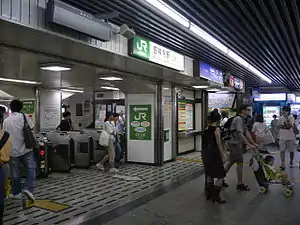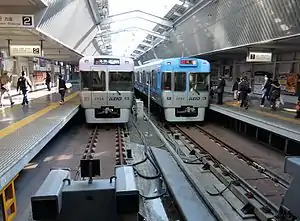Kichijōji Station
Kichijōji Station (吉祥寺駅, Kichijōji-eki) is a railway station serving Kichijōji in Musashino, Tokyo, Japan, operated by East Japan Railway Company (JR East) and the private railway operator Keio Corporation.
Kichijōji Station 吉祥寺駅 | |
|---|---|
 The north side of the station in September 2014 | |
| Location | Kichijōji-Minami-cho, Musashino, Tokyo Japan |
| Operated by | |
| Line(s) |
|
| Connections | Bus terminal |
| History | |
| Opened | 1899 |
| Location | |
 Kichijōji Station Location within Japan | |
Lines
Kichijōji Station is located on the JR East Chūō Main Line, and is served by all-stations Chūō-Sōbu Line services from Chiba and some Chūō Line (Rapid) limited-stop services from Tokyo. It also forms a terminus of the Keio Inokashira Line and is located 12.7 kilometers from the opposing terminus at Shibuya in Tokyo.[1] The station is 14 minutes from Shinjuku and 28 minutes from Tokyo by Chuo Line rapid service, and 23 minutes from Shibuya by Inokashira Line express service.[2]
JR East
JC11 JB02 Kichijōji Station 吉祥寺駅 | ||||||||||||||||||||||||||||||
|---|---|---|---|---|---|---|---|---|---|---|---|---|---|---|---|---|---|---|---|---|---|---|---|---|---|---|---|---|---|---|
| JR East station | ||||||||||||||||||||||||||||||
 JR East entrance, September 2005 | ||||||||||||||||||||||||||||||
| Location | 1 Kichijōji Minami-chō (東京都武蔵野市吉祥寺南町1丁目) Japan | |||||||||||||||||||||||||||||
| Operated by | ||||||||||||||||||||||||||||||
| Line(s) |
| |||||||||||||||||||||||||||||
| Platforms | 2 island platforms | |||||||||||||||||||||||||||||
| Tracks | 4 | |||||||||||||||||||||||||||||
| History | ||||||||||||||||||||||||||||||
| Opened | 30 December 1899 | |||||||||||||||||||||||||||||
| Passengers | ||||||||||||||||||||||||||||||
| FY2014 | 139,580 daily | |||||||||||||||||||||||||||||
| Services | ||||||||||||||||||||||||||||||
| ||||||||||||||||||||||||||||||
Station layout
The JR East station consists of two elevated island platforms serving four tracks.[3] It has a "Midori no Madoguchi" staffed ticket office and a "View Plaza" travel agent.[4]
Keio
 Kichijōji Station 吉祥寺駅 | |||||||||||||||
|---|---|---|---|---|---|---|---|---|---|---|---|---|---|---|---|
| Keio station | |||||||||||||||
 The Keio Inokashira Line platforms, November 2014 | |||||||||||||||
| Operated by | |||||||||||||||
| Line(s) | |||||||||||||||
| Platforms | 2 side platforms | ||||||||||||||
| Tracks | 2 | ||||||||||||||
| History | |||||||||||||||
| Opened | 1 April 1934 | ||||||||||||||
| Passengers | |||||||||||||||
| FY2014 | 144,238 daily | ||||||||||||||
| Services | |||||||||||||||
| |||||||||||||||
Station layout
The Keio station consists of two elevated side platforms serving two terminating tracks.[3]
History
Kichijōji Station opened on 30 December 1899.[3] The Keio station opened on 1 April 1934.[1]
From 22 February 2013, station numbering was introduced on Keio lines, with Kichijōji Station becoming "IN17".[5]
Passenger statistics
In fiscal 2014, the JR East station was used by 139,580 passengers daily (boarding passengers only), making it the twentieth-busiest JR East station.[6] Over the same fiscal year, the Keio station was used by an average of 144,238 passengers daily (exiting and entering passengers).[7]
The passenger figures for previous years are as shown below.
| Fiscal year | Daily average (JR East) | Daily average (Keio) |
|---|---|---|
| 1999 | - | 140,685[1] |
| 2005 | 139,245[8] | - |
| 2006 | 140,155[9] | - |
| 2007 | 143,932[10] | - |
| 2008 | 143,178[11] | - |
| 2009 | 141,314[12] | - |
| 2010 | 138,420[13] | 142,083[14] |
| 2011 | 137,555[15] | 140,929[14] |
| 2012 | 138,483[16] | 141,475[17] |
| 2013 | 139,282[18] | 139,679[17] |
- Note that JR East figures are for boarding passengers only.
See also
References
- Terada, Hirokazu (July 2002). データブック日本の私鉄 [Databook: Japan's Private Railways]. Japan: Neko Publishing. p. 206. ISBN 4-87366-874-3.
- "吉祥寺駅". えきから時刻表. Retrieved 18 December 2013.
- Kawashima, Ryozo (April 2010). 日本の鉄道 中部ライン 全線・全駅・全配線 第1巻 東京駅―三鷹エリア [Railways of Japan - Chubu Line - Lines/Stations/Track plans - Vol 1 Tokyo Station - Mitaka Area]. Japan: Kodansha. p. 12/40. ISBN 978-4-06-270061-0.
- 各駅情報(吉祥寺駅) [Station Information (Kichijōji Station)] (in Japanese). Japan: East Japan Railway Company. Retrieved 10 January 2012.
- 京王線・井の頭線全駅で「駅ナンバリング」を導入します。 [Station numbering to be introduced on Keio Line and Inokashira Line] (PDF) (in Japanese). Keio Corporation. 18 January 2013. Retrieved 25 March 2013.
- 各駅の乗車人員 (2014年度) [Station passenger figures (Fiscal 2014)] (in Japanese). Japan: East Japan Railway Company. 2015. Archived from the original on 6 May 2001. Retrieved 6 February 2016.
- 1日の駅別乗降人員 [Average daily station usage figures] (in Japanese). Japan: Keio Corporation. 2014. Retrieved 25 March 2016.
- 各駅の乗車人員 (2005年度) [Station passenger figures (Fiscal 2005)] (in Japanese). Japan: East Japan Railway Company. Archived from the original on 9 October 2014. Retrieved 9 August 2012.
- 各駅の乗車人員 (2006年度) [Station passenger figures (Fiscal 2006)] (in Japanese). Japan: East Japan Railway Company. Retrieved 9 August 2012.
- 各駅の乗車人員 (2007年度) [Station passenger figures (Fiscal 2007)] (in Japanese). Japan: East Japan Railway Company. Retrieved 9 August 2012.
- 各駅の乗車人員 (2008年度) [Station passenger figures (Fiscal 2008)] (in Japanese). Japan: East Japan Railway Company. Retrieved 9 August 2012.
- 各駅の乗車人員 (2009年度) [Station passenger figures (Fiscal 2009)] (in Japanese). Japan: East Japan Railway Company. Retrieved 9 August 2012.
- 各駅の乗車人員 (2010年度) [Station passenger figures (Fiscal 2010)] (in Japanese). Japan: East Japan Railway Company. Archived from the original on 6 October 2014. Retrieved 9 August 2012.
- 1日の駅別乗降人員 [Average daily station usage figures] (in Japanese). Japan: Keio Corporation. 2013. Retrieved 25 March 2013.
- 各駅の乗車人員 (2011年度) [Station passenger figures (Fiscal 2011)] (in Japanese). Japan: East Japan Railway Company. Archived from the original on 6 May 2001. Retrieved 9 August 2012.
- 各駅の乗車人員 (2012年度) [Station passenger figures (Fiscal 2012)] (in Japanese). Japan: East Japan Railway Company. Archived from the original on 7 October 2014. Retrieved 3 September 2014.
- 1日の駅別乗降人員 [Average daily station usage figures] (in Japanese). Japan: Keio Corporation. 2013. Retrieved 3 September 2014.
- 各駅の乗車人員 (2013年度) [Station passenger figures (Fiscal 2013)] (in Japanese). Japan: East Japan Railway Company. Archived from the original on 6 May 2001. Retrieved 3 September 2014.
External links
| Wikimedia Commons has media related to Kichijoji Station. |
- JR East station information (in Japanese)
- Keio Station information (in Japanese)
.jpg.webp)